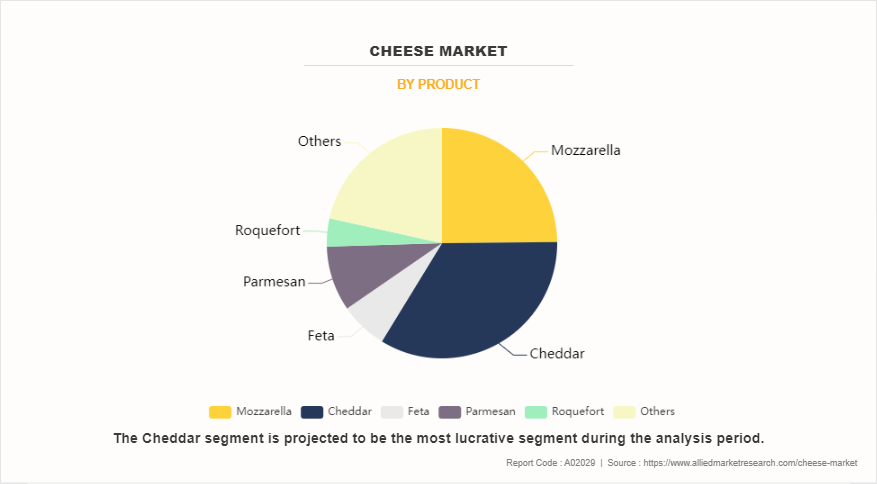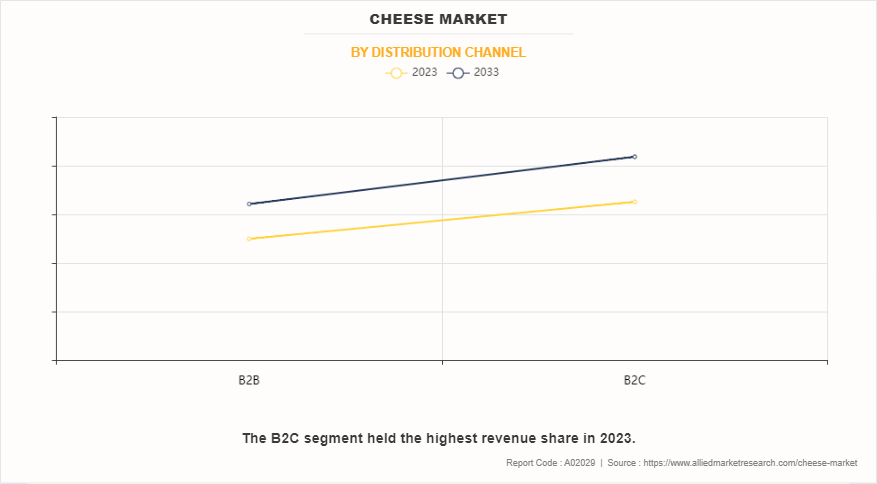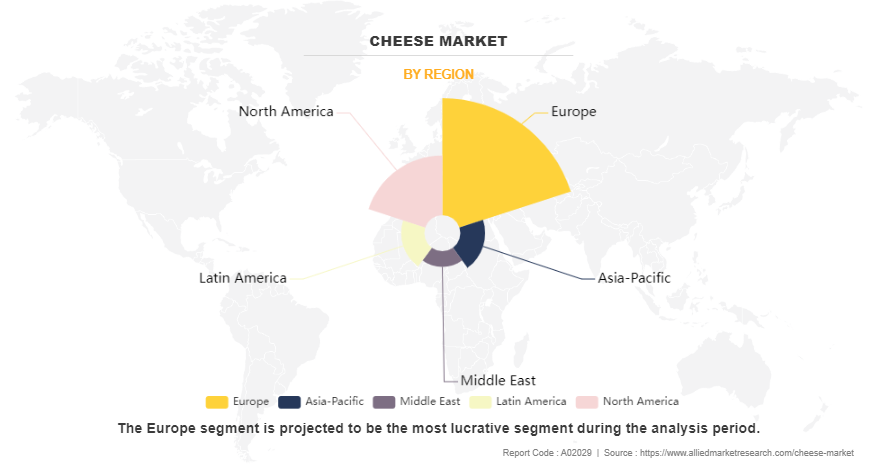Cheese Market Research, 2033
The global cheese market size was valued at $172.6 billion in 2023 and is projected to reach $222.0 billion by 2033, growing at a CAGR of 2.6% from 2024 to 2033.
Cheese is one of the most consumed food products, owing to its high nutritious value along with the presence of necessary vitamins, proteins, and other nutrients. It is a rich source of calcium that helps to maintain strong teeth and increases bone strength. Further, cheese contains linoleic acid and sphingolipids, which helps to prevent cancer.

Key Takeaways
- By source, the cow milk segment dominated the global cheese market in 2023.
- By type, the natural cheese segment dominated the market in terms of revenue in 2023.
- By product, the cheddar segment dominated the market in terms of revenue in 2023.
- By distribution channel, the B2C segment dominated the market in terms of revenue in 2023.
- By region, Europe dominated the cheese industry in terms of revenue in 2023. However, Latin America is anticipated to grow at the highest CAGR during the forecast period.
Market Dynamics
Cheese is a popular dietary source for various nutrition and health-promoting compounds, which help the body to function properly. It provides a larger number of nutritional supplements in concentrated form. Nutrients such as protein, calcium, phosphorus, zinc, vitamins A, B12, and sodium are the most commonly found elements in cheese. Cheese also contains a large amount of protein which can vary from 15 grams to 45 grams (per 100 gram) as per the type of cheese. Other nutrients present in the cheese include calcium which is beneficial for strong bones and teeth; zinc which helps to maintain a healthy immune system, vitamin A necessary for good vision, heart, kidney & lung function; and vitamin B12 is important for the nervous system & blood production. Increased demand for cheese is likely to be witnessed owing to its associated health benefits.
Organic is one of the trending market requirements which is common in almost every food & beverage product including dairy and dairy products. As consumers are becoming health conscious and are aware of the unhealthy production of goods in the market and their side effects on the body, the consumers are raising the demand for organic products in the cheese market. Moreover, organic cheese is as popular as the other organic agricultural products available in the market, as this cheese category is produced without using any growth hormones, antibiotics, or harmful pesticides.
Also, the milk that is used to produce the organic cheese is collected from all the organic farms where cows only eat organically grown food and grasses. Therefore, with the growing demand for organic products, the demand for organic cheese is also rising with high impetus, and many key players are already engaged in the production of organic cheese such as the organic valley, mother dairy, and grass-fed raw are few among them.
Quick service restaurants are a specific kind of restaurant which is into serving fast food. Some of the popular examples of QSR include Pizza Hut, Domino’s Pizza, Taco Bell, Burger King, Subway, McDonald's, Starbucks, and KFC. Cheese has been widely accepted in cuisines by the QSRs. Dominos, a popular QSR across the world, sells 3 million pizzas every day and has 18,000 stores in more than 90 countries around the world. The brand is likely to expand its presence in the developing countries.
Furthermore, other QSRs are following suit and are rapidly expanding across the world with the growing popularity of fast food. Furthermore, factors such as value-priced offerings, younger demographics, and the growth in online food ordering owing to the emergence of food aggregators are expected to be the key growth drivers for the QSR business which is propelling the demand for cheese as well. Therefore, the proliferation of QSRs propels the growth of the cheese market.
Expansion of retail channels plays a pivotal role in driving the growth of the cheese market by enhancing accessibility and consumer convenience. With the proliferation of supermarkets, hypermarkets, convenience stores, and online platforms, consumers have a wider array of options to purchase cheese. The increased availability of cheese across diverse retail channels not only ensures greater visibility but also caters to varying consumer preferences and shopping habits. This accessibility fosters impulse purchases and encourages consumers to experiment with different cheese varieties, flavors, and brands, thereby driving overall market demand.
Furthermore, the expansion of retail channels facilitates geographic reach, enabling cheese producers to penetrate new markets and reach a larger consumer base. As supermarkets and hypermarkets expand their footprint in urban and rural areas alike, consumers in previously underserved regions gain access to a diverse range of cheese products. Additionally, the convenience of online shopping platforms allows consumers to browse, compare, and purchase cheese products from the comfort of their homes, further boosting cheese market growth. Overall, the expansion of retail channels enhances market penetration, fosters consumer engagement, and stimulates the growth trajectory of the cheese market.
Rising disposable incomes have a profound impact on the cheese market, driving its growth in various ways. As consumers' purchasing power increases, they are more inclined to spend on premium and indulgent food items, including specialty cheeses and gourmet varieties. This trend is particularly evident in both developed and emerging markets, where consumers are willing to allocate a larger portion of their budgets to food products that offer sensory experiences and perceived value. As a result, cheese producers and retailers are capitalizing on this trend by introducing high-quality and artisanal cheese options, expanding the range of choices available to consumers and fueling market growth.
Moreover, rising disposable incomes often coincide with shifts in dietary patterns towards more diverse and international cuisines. Cheese, being a versatile ingredient in various cuisines worldwide, benefits from this trend as consumers seek out new and exotic flavors. Additionally, higher disposable incomes enable consumers to explore cheese beyond basic varieties, encouraging experimentation with premium cheese products and specialty imports. Overall, rising disposable incomes create favorable conditions for the cheese market's growth by increasing consumer spending on premium cheese offerings, driving demand for diverse cheese varieties, and supporting culinary exploration and experimentation.
Premiumization and artisanal offerings present significant opportunities for the cheese market by tapping into consumers' growing desire for unique and high-quality culinary experiences. Artisanal cheeses, crafted using traditional methods and premium ingredients, cater to discerning consumers seeking authenticity, craftsmanship, and distinct flavor profiles. This trend aligns with the broader movement towards artisanal and gourmet food products, driven by consumers' willingness to pay a premium for superior quality and unique taste sensations.
Moreover, premiumization allows cheese producers to differentiate their products in a crowded market landscape, thereby commanding higher price points and margins. By focusing on premium offerings, producers can capitalize on the perception of cheese as a sophisticated and indulgent culinary choice, appealing to consumers' desire for elevated dining experiences. Additionally, premium and artisanal cheeses often have strong storytelling and regional associations, providing opportunities for producers to engage consumers through narratives of heritage, craftsmanship, and terroir, further enhancing the perceived value of their products. Overall, premiumization and artisanal offerings not only create opportunities for producers to capture higher margins but also enable them to cultivate brand loyalty and cater to evolving consumer preferences for unique and upscale cheese experiences.
Segments Overview
The cheese market analysis is segmented into source, type, product, distribution channel, and region. By source, the market is divided into cow milk, sheep milk, goat milk, and buffalo milk. By type, the market is segmented into natural cheese and processed cheese. By product, the market is divided into mozzarella, cheddar, feta, parmesan, Roquefort, and others. By distribution channel, the market is divided into B2B and B2C. Region-wise, the cheese market size is analyzed across North America, Europe, Asia-Pacific, Latin America, and Middle East and Africa
By Source
By source, the cow segment held the major share of the market in 2023. Cow’s milk is the most common type of milk used for manufacturing cheese. Today, most dairy products are made from cow’s milk. The popularity of cheese has been on the upsurge, with a per capita average of 13.1 Kg per year as of 2020. Furthermore, cow’s milk has been dominating the cheese industry for ages owing to the versatility and variety of cow’s milk available in the market and the ease of production of different styles of cheese. High production of cow’s milk from various countries such as India, the U.S., France, Russia, and New Zealand drives the demand for the use of cow’s milk in cheese production.

By Type
By type, the natural segment held the major share of the market in 2023 and is expected to maintain its dominance during the forecast period. Natural cheese is made from fresh milk derived from farm animals. The color, texture, taste, and smell of the cheese come from the milk used while preparing cheese, the processes by which the cheese is made, environmental factors such as temperature & pressure, and the time required to age the cheese. Recent years have witnessed increased demand for natural cheese. This is mainly owing to the associated health benefits of soft cheese. Natural cheese contains high protein content and source of minerals and various vitamins, which helps in the reduction of cardiovascular diseases and osteoporosis. Furthermore, the surge in the trend of cross-culture food consumption and adoption in various countries around the world has highly influenced the demand for natural cheese.
By Product
By product, the cheddar segment held the cheese market share in 2023 and is expected to maintain its dominance during the forecast period. Cheddar cheese is made only from cow milk and is a hard cheese. In addition, determined by coating, age, pasteurization, and cheese cultures diversities of Cheddar cheese vary greatly from each other both in terms of texture and taste. Cheddar cheese is highly popular owing to its harder texture, creamier & sharp taste, and longer shelf life. This cheese is widely used in fast food, savory snacks, and bakery products. The price of cheddar cheese is low as compared to that of other cheese such as mozzarella cheese. This increases its affordability among the buyers. Therefore, propelling the demand for cheddar cheese in the market.

By Distribution Channel
By distribution channel, the B2C segment held the major share of the market in 2023 and is expected to maintain its dominance during the forecast period. Supermarkets and hypermarkets are gaining high popularity owing to the availability of a broad range of consumer goods under a single roof, ample parking space, and convenient operation timings. Moreover, an increase in urbanization, a rise in working-class population, and competitive pricing boost the popularity of supermarkets and hypermarkets in the developed and developing regions. Furthermore, these stores offer a variety of brands in a product category, including cheese, thus offering more options for consumers to buy cheese as per their requirements. Moreover, the presence of store associates to help the consumers choose the right product and provide product knowledge boosts the growth during cheese market forecast.

By Region
Region-wise, Europe held the major market share of the cheese market in 2023. The European region is the epicenter of cheese production and consumption. Europe is known to have a large variety of cheese and can cater to the demands of the world. Major countries in cheese production are France, Italy, the UK, and Greece. With ever-rising demands for cheese around the world, Europe became the hub for cheese export and producer of some of the high-quality cheese in the world. In addition, France has the highest per capita consumption of any other country in Europe, Brie, camembert, and Roquefort are some of the most famous cheeses from France. In addition, the surge in consumption of authentic cheese, the rise in demand for cheese as a major ingredient in cuisines, are escalating the cheese market growth.

Competitive Analysis
Competitive analysis provides valuable insights into the competitive landscape of a market by evaluating key players, their strengths, weaknesses, strategies, and market positioning. It involves assessing factors such as cheese market share, product offerings, pricing strategies, distribution channels, and customer perception. By analyzing competitors' actions and reactions, businesses identify opportunities, anticipate threats, and make informed decisions to gain a competitive advantage.
This analysis helps in understanding cheese market trends, customer preferences, and industry dynamics, enabling companies to refine their strategies, innovate products, improve customer experiences, and effectively position themselves in the market. Competitive analysis facilitates strategic planning and enhances competitiveness in a dynamic business environment.
Major players such as Bel Group, Fonterra Food, and Gujarat Cooperative Milk Marketing Federation Ltd have adopted partnership, agreement, and acquisition as key developmental strategies to improve the product portfolio of the cheese industry.
Key Benefits For Stakeholders
- This report provides a quantitative analysis of the market segments, current trends, estimations, and dynamics of the cheese market analysis from 2023 to 2033 to identify the prevailing cheese market opportunities.
- The market research is offered along with information related to key drivers, restraints, and opportunities.
- Porter's five forces analysis highlights the potency of buyers and suppliers to enable stakeholders make profit-oriented business decisions and strengthen their supplier-buyer network.
- In-depth analysis of the cheese market segmentation assists to determine the prevailing market opportunities.
- Major countries in each region are mapped according to their revenue contribution to the global market.
- Market player positioning facilitates benchmarking and provides a clear understanding of the present position of the market players.
- The report includes the analysis of the regional as well as global cheese market trends, key players, market segments, application areas, and market growth strategies.
Cheese Market Report Highlights
| Aspects | Details |
| Forecast period | 2023 - 2033 |
| Report Pages | 320 |
| By Source |
|
| By Type |
|
| By Product |
|
| By Distribution channel |
|
| By Region |
|
| Key Market Players | Gujarat Cooperative Milk Marketing Federation Ltd., Savencia SA, The Bel Group, Arla Foods, Saputo Inc., Lactalis Group, Britannia Industries Limited, ASSOCIATED MILK PRODUCERS INC., Fonterra Food, The Kraft Heinz Company |
Analyst Review
Various CXOs from leading companies perceive that flavored processed cheese and innovation in cheese processing are the main areas for market growth in the cheese market. Retail market expansion and economic growth in advanced and emerging economies support the cheese market growth. However, the increase in health awareness and the high perishability nature of cheese among consumers are projected to hinder the market growth. According to the CXOs, Asia-Pacific is projected to register significant growth as compared to the saturated markets of Europe and North America due to an increase in penetration of a wide range of cheese.
CXO further added that there is a need for sustainable packaging in the cheese industry as according to National Geographic 18 billion pounds of plastic flows into the ocean every year and only 9% of the total plastic produced has been recycled. Also, 79% of it is currently dumped into landfills or discarded in the natural environment. Therefore, there is a need for sustainable packaging of dairy products including cheese which in resultant have led many key players to step toward eco-friendly and sustainable packaging.
Apparently, a global paper packaging group named Mondi and Hazeleger Kaas Company has entered into a partnership to promote sustainable packaging of cheese. By working together, they have produced a cheese packaging with PP thermoforming top and bottom web, and PP label so that the packaging can be entirely recycled which was not possible previously. Therefore, due to the growing environmental concern sustainable packaging is projected to shape the future packaging of cheese and other dairy products.
The global cheese market size was valued at $172.6 billion in 2023 and is projected to reach $222.0 billion by 2033
The global Cheese market is projected to grow at a compound annual growth rate of 2.6% from 2024 to 2033
The Kraft Heinz Company, ASSOCIATED MILK PRODUCERS INC., The Bel Group, Saputo Inc., Fonterra Food, Britannia Industries Limited, Gujarat Cooperative Milk Marketing Federation Ltd., Lactalis Group, Savencia SA, Arla Foods
Region-wise, Europe held the major market share of the cheese market in 2023.
The surge in QSRs and fast casual restaurant business augmenting the market, The increase in demand for nutrient-rich food is propelling the market growth, Rise in demand for organic cheese is driving the market.
Loading Table Of Content...
Loading Research Methodology...



